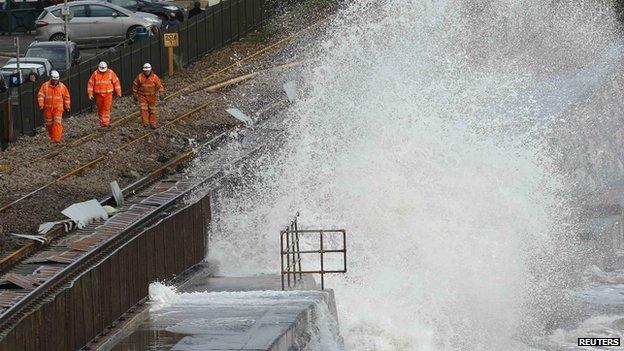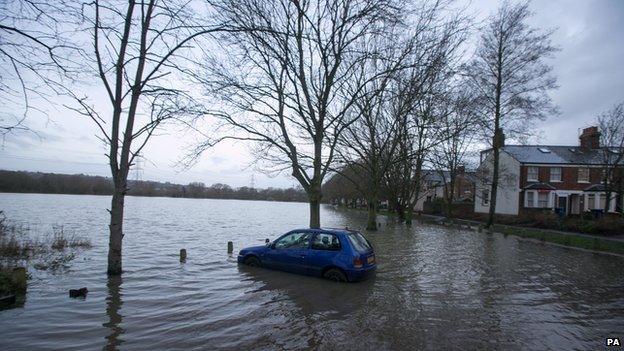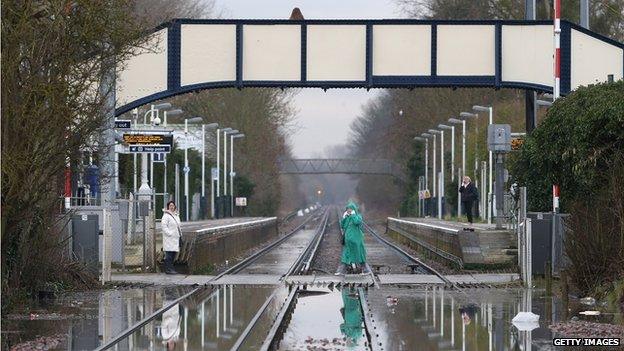Can UK transport networks cope with floods?
- Published

The collapse of the Cornwall-Devon railway line at Dawlish has worsened transport woes
The storms that cut off rail links to Cornwall and much of Devon from the rest of the country have raised some fundamental questions about the resilience of our transport systems in bad weather.
The dramatic images of the rail line suspended above the sea at Dawlish have captured the headlines, but BBC research into the findings of the industry's regulator shows underlying vulnerabilities, because of delays in maintenance and drainage work.
The Office of Rail Regulation (ORR) has said that Network Rail, which is responsible for the railway tracks, was behind in 16% of its plans to renew embankments and cuttings.
And last year it said 40% of the network's drainage had not been assessed, despite 180 earthwork failures occurring in 2012 and 2013.
The regulator's reports described this number as "large". Since then there have been more than 30 landslides affecting rail journeys in just a few weeks, as rain weakens steep-sided slopes.
The ORR told the BBC that Network Rail was moving in the right direction, but had not done enough to understand or attend to the condition of these vital assets, which hold up thousands of miles of track.
"There is more we can do - that's why we asked the regulator for extra funding in the coming five-year period," said Kevin Groves of Network Rail.
"And there are examples of very practical, tangible things we're doing to make our railway more resilient, but with the size of the network that we have it takes time," he added.
Rail is key to moving freight around as well as passengers, so there is a wider economic implication for track failure from flooding or collapse.
That is an argument being made by city authorities in Oxford who say damage to rail and road infrastructure is hitting their local economy hard.

Osney Industrial Estate was one of several areas in Oxford badly affected by the floods
The estimated cost of flooding on two main roads, which caused gridlock in the centre, was more than £40m, according to the leader of the city council. And he said that was just for one week.
The railway line south of the city centre also flooded, badly affecting passenger services to London. But the same stretch of line is the only freight route between Southampton Docks and the north of England and the West Midlands.
Oxford City Council asked Network Rail to consider flood-proofing the line when it was carrying out other engineering work more than three years ago.
"They raised the bridge by 3ft to allow for electrification gantries underneath, but didn't raise the railway line, which they could have done. Network Rail decided against it, which was a mistake, if they had done that then the line wouldn't get flooded," said Bob Price, leader of Oxford City Council.
"It's crucial to export trade and also a lot of people commute to London. For them losing capacity to get there easily is a disaster."
Network Rail told the BBC's File on 4 programme the flood protection work couldn't be done until it had convinced the Environment Agency the scheme wouldn't flood nearby homes.
This week the same stretch of line was flooded again.
The problem for places like Oxford is the way the Environment Agency prioritises flood defence spending. Unsurprisingly, threat to home and life comes at the top of the list when it comes to spending money.
But the government's environmental advisory body, the Committee on Climate Change, has used the Environment Agency's own building plans to put an estimated price tag on the cost of not doing work deemed necessary, but that is too expensive to build now.
It reckons damage from missing defences could cost the UK £3bn in the longer term.
"I think that the consequences of infrastructure failure we've seen this winter mean that needs to be given priority," said Prof Jim Hall, an academic who specialises in the impact of floods on infrastructure.
"Leadership on this is spread around the place, so there are a number of organisations working on it, but really it needs to be joined up.
"There needs to be more of a grip on the scale of the risk and monitoring and making sure the right steps are being taken to keep the risk under control."

Railway lines in the Berkshire village of Datchet have been flooded
Louise Ellman, chairwoman of the Commons transport committee, is unimpressed by the efforts of the government and the rail industry.
"There is not enough urgency, nor a sufficiently holistic approach from government as a whole with the right leadership shown and within the rail industry," she said.
"Nobody can anticipate everything and nobody can prevent every incident. But it is possible to plan ahead, know the weather has changed, and know what the impediments on the line are."
The government has said it will continue to do everything it can to tackle the urgent problems faced now, as well as protecting the UK's transport networks in the long term.
The Department for Environment, Food and Rural Affairs said it was spending £3.1bn on flood defences over the life of this Parliament, which was more than ever before.
"We fully understand the importance of transport resilience," a spokesman said.
"Planning for the impacts of extreme weather and climate change are a key part of the huge levels of investment we are providing in our transport infrastructure. We will continue to do everything we can to both tackle the urgent problems we face as well as protecting the UK's transport networks in the long term."